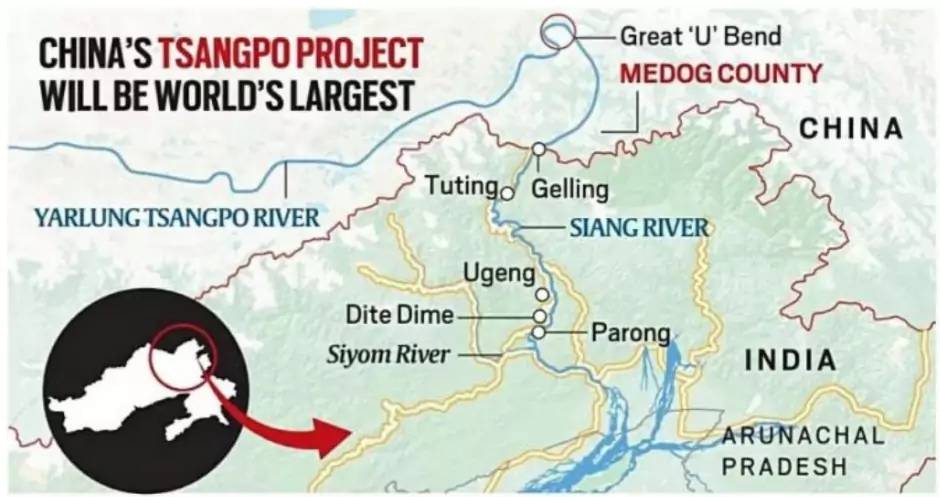China has officially begun constructing a massive hydropower dam on the Yarlung Zangbo (Brahmaputra) in Tibet’s Medog county near the Arunachal Pradesh border.
It will be the world’s largest hydropower project and has raised strategic, ecological, and diplomatic concerns in India and Bangladesh.
About the TsangpoProject
- Located near the Great Bend in Medog County, Tibet, where the Yarlung Tsangpo drops ~2,000 metres, creating ideal conditions for hydropower generation
- Objective: To generate 60,000 MW, thrice the capacity of China’s Three Gorges Dam.
- It will significantly control flow of the Siang (Brahmaputra) before it enters Arunachal Pradesh.
Riparian States
The terms “riparian states” refer to countries or regions that are situated along the banks of a river.
- Upper Riparian State: A country located at the upstream or source end of the river
- It has geographical control over the river’s origin and often the first access to the water flow.
- Lower Riparian State: A country located downstream of the river flow.
- It is dependent on the water that flows from the upper riparian country.
|

Course of the River Brahmaputra
- Origin: Rises as the Yarlung Tsangpo in the Tibet Autonomous Region of China.
- Enters India through Arunachal Pradesh (as Siang/Dihang), flows through Assam, and then enters Bangladesh.
- Merges with the Ganges (Padma) and empties into the Bay of Bengal.
Different Names of the Brahmaputra River Across Regions
- Tsangpo: Tibet – Upper course of the Brahmaputra, meaning “The Purifier”.
- Yarlung Zangbo Jiang: In China
- Siyang/Dihang: Arunachal Pradesh, as it enters India.
- Brahmaputra: Assam, Main stretch of the river in India.
- Jamuna: As it enters Bangladesh.
- Padma: After Jamuna merges with the Ganga.(in Bangladesh)
- Meghna: Final stretch before entering the Bay of Bengal.
|
Implications of Dam Project on India
- Weaponising Water Resource:
- China can control Brahmaputra’s flow, creating strategic pressure on India.
- Risk of flooding due to sudden water release from upstream reservoirs.
- Possibility of drought-like situations during dry seasons due to restricted flow.
- The dam’s location near the disputed border increases its strategic value for China.
- Agriculture:
- Reduced River Flow: Reduced water availability may affect irrigation in Arunachal Pradesh and Assam.
- Livelihood Loss: Farmers dependent on the Brahmaputra and its tributaries may face reduced crop yields or crop failure.
- Seismic Threat:
-
- Earthquake-Prone Zone: Tibet is part of a highly seismically active region; a dam breach could trigger catastrophic downstream flooding.
- Downstream Ecosystem Impact: Fluctuating water levels may impact aquatic biodiversity, wetlands, and forest ecosystems in India.
- Diplomatic Tensions: The dam adds another layer of complexity to India-China relations, especially over transboundary river sharing.
![]() 28 Jul 2025
28 Jul 2025


